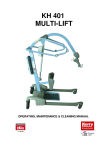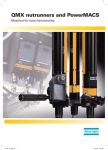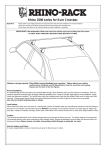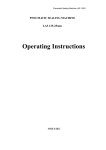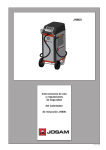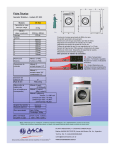Download El-Max Nutrunner 1.5 - EL
Transcript
Specifications El-Max Nutrunner 1.5 Height: 1045mm Width: 620mm Length: 1380mm Working height, max: 885mm Working height, min: 325mm Weight: 59kg Motor power: 1.1 kW (1.5 hp) Electrical power: 3-phase 230/400V 50Hz Tool socket: 1” square, female User Manual El-Max Nutrunner satisfies all the European safety requirements of the EU Machinery Directive for electrical equipment. Among other things, the machine is equipped with disconnecting switches and thermostat to protect the motor. If you wish to contact us, we can be reached by email: [email protected] Or by telephone on +46 (0)31 128017. El-Max Nutrunner AB Sockerbruket 30 S-414 51 Göteborg www.el-max.se Phone/Tel: +46(0)31 12 80 17 Fax: +46(0)31 12 23 89 [email protected] Reg no. Bank: 14-556177-0974 Nordea VAT No. SE 556177097407 Plusgiro 241652-7 Swift code/BIC: NDEASESS IBAN: SE83 9500 0099 6042 0241 6527 El-Max Nutrunner 1.5 445 rpm Maintenance and Service of the El-Max Impact Wrench. Important The El-Max Nutrunner 1.5 must only be used for loosening and removing wheel nuts. The machine must only be used on level ground and not on a table or in an otherwise raised position. If the body of the machine is disengaged (for instance when the machine is placed on its side for transportation) and the lifting spring is released (left handle pushed in), the wheel setting can eject with force and possibly cause bodily injury. Therefore, the machine must be lowered to its lowest position and held in place with rope, plastic tape or the like. Do not touch any rotating parts while the machine is in operation. Fastening wheel nuts Plug into the outlet Place an El-Max socket (with the proper diameter for the nut to be screwed in) in the socket spanner tube. Screw on the socket. Manually screw on the nut a little. Turn the start knob on the El-Max Nutrunner 1.5 to setting 2 1st impact ±360 Nm (knob springs back to operating position 1). 2nd impact ±510 Nm Adjust to the proper work height by holding in and releasing 3rd impact ±630 Nm the left handle. Place the power socket on the nut. 4th impact ±700 Nm Hold in the right handle to make the flywheel rotate. Make a distinct impact with the left thumb on the Stroke Control. The force is now transferred through the Socket Spanner Sleeve to the nut. Repeat the procedure with the Stroke Control until the nut has been tightened with the desired force (see table). The machine’s stroke force has been tested by Chalmer’s Testing Institute in Göteborg, Sweden. Unfastening the wheel nuts Plug into an outlet. Place an El-Max socket (with the proper diameter for the nut to be screwed in) in the socket spanner tube. Screw on the socket. Turn the start knob on the El-Max machine to setting 2 (knob springs back to operating position 1). Adjust to the proper work height by holding in and releasing the left handle. Place the socket on the nut. Hold in the Right Handle to make the flywheel rotate. Make a distinct impact with the left thumb on the Stroke Control. The power is now transferred through the Socket Spanner Tube to the nut. On impact, the Flywheel and motor should stop because the impact mechanism locks up. Immediately release the right handle and left button. (By not releasing the right handle, the motor can overheat.) If the motor overheats, the thermostat is triggered. If this happens, switch off the machine and wait a few minutes. Note: An idle motor can become damaged. Press the right handle again and repeat the procedure until the nut loosens. Warning: The power must always be off during service and maintenance of the machine. Lubrication The El-Max Impact Wrench requires lubrication to ensure optimal performance and a long service life. All moving parts require a little oil occasionally. Take care, We recommend designating a person at the workplace to however, not to get oil and/or grease on the brake bands. perform maintenance on this Keep the rods on the wheel frame clean and greased, so the machine. machine easily glides up and down when you press the left This will ensure proper handle in. lubrication. Use the lubrication nipple on the socket spanner tube to grease between the Socket Spanner Tube and Flywheel. You will find the lubricator nipple in the hole in the round cover at the front of the machine. If you can’t see the lubricator nipple, turn the Socket Spanner Tube. Replacement of belts The belts on the machine become worn over time. These should be replaced if the machine begins to seem worn out. Check tightened wheel nuts occasionally using a torque wrench to ensure that the machine is still putting out the desire force. Loosen the nuts holding the axle to the flywheel. These nuts are located inside the machine under the top protective cover. The Socket Spanner Tube, Flywheel and Axle are now loose. Pull the Flywheel forward to remove these parts. Install the new belts. Uncover the upper brake on assembly. There must be 0.5-2 mm of space between the Flywheel and the Socket Spanner Tube. When replacing belts, be sure to check the brake bands, so they do not become worn (should be at least 2 mm thick). Belt adjustment Adjust the belts using the M8 adjusting screw located closest to the flywheel underneath the top protective cover. Adjust ½ revolution at a time until the belts are adequately taut (do not spin when the right handle is pressed). The belts must disengage when the right handle is released. DATA Noise output Measurements were taken in a tyre workshop under normal operating conditions for El-Max Impact Wrenches. Sound pressure levels 1 m from the machine’s surface and 1.6 m from the floor. Measuring equipment: Brüel & Kjaer type 2231 Precision Sound Level Metre. Equivalent continuous A-weighted sound pressure level: -Idling with flywheel in motion: 67db(A) -Operating mode: 83 dB (A). 83 dB (A) is the mean value of 5 measurements of the equivalent sound pressure level. Each measurement consists of 5 recoveries and 10 impacts during 85 sec. -Maximum C-weighted sound level value: 123 dB. 123 dB is the highest value on measurement of 5 impacts. Vibrations When idle (i.e. no impact), the machine is under 2.5 m/s2.









